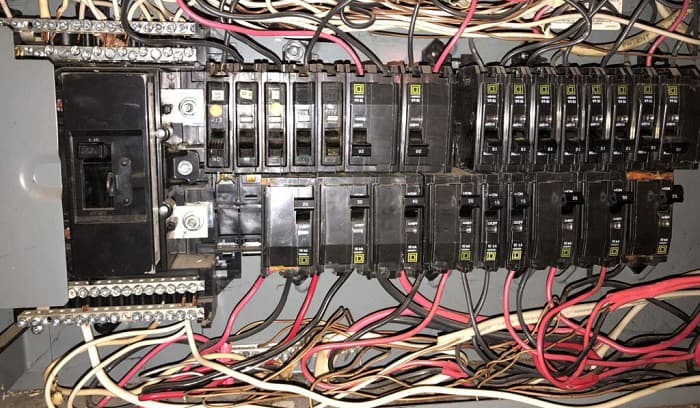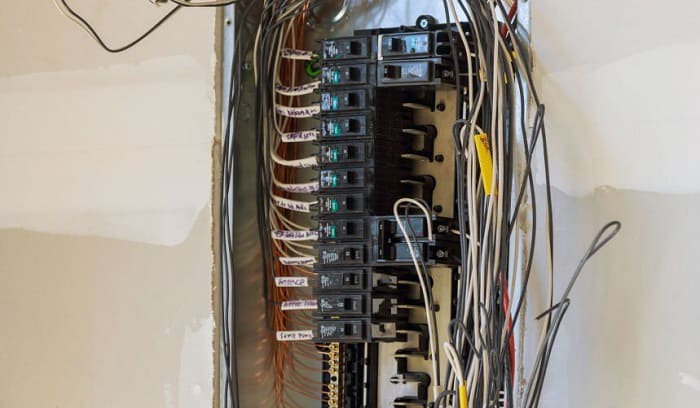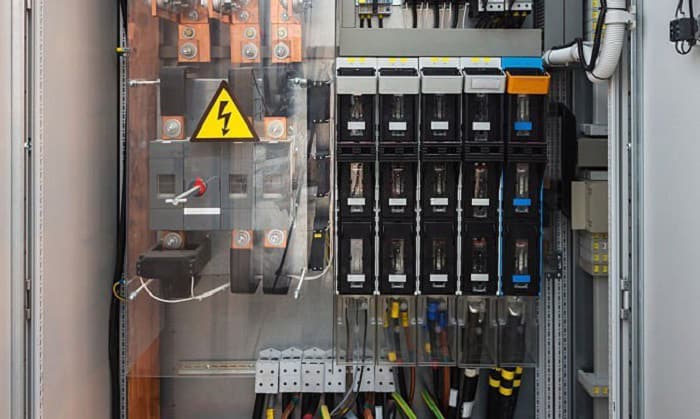“How big of a subpanel can I install off a 100 amp service?” You can install a sub panel that’s higher than the main’s amp rating – even up to 100,000 amps. However, the moment your subpanel’s loads reach more than 100 amps, it will always trip because it’s limited to that maximum ampacity.
That’s why it’s important to pinpoint your exact power requirements when adding a subpanel to 100 amp service. You can use breakers with amp ratings that are exactly or lower than 100A. Always pair the feeder breaker or main breaker with the right conductor size.
Table of Contents
The Key Things to Remember When Sizing Subpanels
Besides knowing all sub panel code requirements (Via Electrical-ServiceSubpanel-Checklist-PDF), the most important thing I tell people who want to install an electrical sub panel, especially when they’re failing to size sub panel correctly, is this: The feeder breaker’s amp rating matters more than the subpanel’s rating.
- Installing a 100 amp subpanel is fine since you can protect it with a 100 amp breaker from the main, which is that panel’s maximum amp rating. You can feed it using the main breaker, assuming the wire size for the subpanel matches the main’s.
- That also means if you have a 200 amp subpanel that just happens to be available or has been gifted to you, there’s absolutely no problem if you decide to have it run off 100 amp service.
However, since it’s feeding from a 100 amp service, it will trip once the subpanel’s circuits draw over 100 amps. You can only logically pair it with as large a conductor as a 4-gauge wire, which works well for a 100 amp breaker.
Don’t even try to fit a 200 amp breaker into the service because the buses, which are rated for only 100 amps, won’t let you anyway.
In such cases, it’s better just to upgrade the main panel altogether or make the 200 amp subpanel the main panel by installing the main breaker in it. You end up future-proofing your electrical system, so it’s a win-win.
- Finally, one question people have is, “How many 50 amp breakers can I put in a 100 amp panel, and is it allowed?” The answer is, yes; feel free to plug in as many as you can physically fit in the panel. You need to use 6-gauge copper wires for them.
What Size Wire Do I Need for Different Subpanels?
This will always be determined by the feeder breakers on the service. Pay attention to possible voltage drops due to distance as well. You’ll likely have to deal with it if your whole wiring run spans longer than 100 feet.
- I’m going to go ahead and assume you’re installing a subpanel in a garage. The most commonly suggested breaker size rating for such projects is 60 amps unless you intend to run a whole bunch of tools at once.
For that, I recommend a 60 amp sub panel off 100 amp main that will be fed by a 60 amp breaker with a wire size of 6 AWG or 4 AWG if the distance reaches over 100 feet.
- If you’re adding a 100 amp subpanel, make sure to use 4 AWG and bump it up two sizes to 2 AWG if you’re facing a 5% voltage drop. You don’t need a 100 amp wire size calculator to figure those out. Just stick to the charts! (via ampacities)
What Are the Components of Your Home’s Electrical System?
The most fundamental components include the main panel with its breakers and wires. This combination makes sure that power will be distributed properly and safely throughout your property.
The individual switches and outlets in every room allow you to utilize the distributed electricity.
We also can’t forget the individual loads (i.e. appliances, lights, gadgets, tools) that are being powered by the said electricity.
Of course, should the need to expand the system arise, subpanels enter the picture, such as when you’ve filled up all the 40 or 42 total slots of your 200 amp service and are considering 100 amp sub panel installation to add more circuits.
Lastly, the electric meter tells you how much power you’re consuming over time or close to real-time, such as in the case of smart meters.
Can I Have Multiple Subpanels?
“How many subpanels can I have?” is also a question that people ask me every once in a while.
I always tell them that as long as you know the maximum loads and current that your main service can handle, how to size your subpanel according to those loads, and you can take care of subpanel installation cost, you can install any number of subpanels.
Incidentally, while there are not many extra advantages in a 100 amp sun panel with main breaker, it does allow you to cut off the power without going to the main service. This could be arguably helpful if the sub panel’s located quite a way from it.
Frequently Asked Questions
How many sub panels can you have on a 100 amp service?
You can run any number of sub-panels that you see fit. Just make sure that you’re not putting more load than what the 100 amp service can handle.
Furthermore, make sure that you’re using the correct wire for the breaker that you decided to install. Should you choose to not touch the wiring that’s already in place, you’ll have to ensure that you’re using the right breaker size.
Don’t forget about the expenses. On average, the cost to install 100 amp sub panel is $1,000.
Can you run a 50 amp sub panel off 100 amp main?
This is perfectly fine. Use a 50 amp feeder breaker from the main, then feed the sub panel using 6-gauge wires.
Can I add a 60 amp subpanel to a 100 amp panel?
Yes, you can feed it with a 60 amp breaker from the sub panel, then use a 6 AWG or 4 AWG wire.
But, for instance, you already have a wire in place that’s meant for the main breaker and also happens to be suitable for the subpanel’s ampacity, you can direct feed it from that breaker and forgo adding a dedicated feeder breaker for it.
Conclusion
So, to wrap up my answer to “How big of a subpanel can I install off a 100 amp service?”, here’s a list of the points you need to remember:
- Know your subpanel’s exact load requirements.
- Look at the feeder breaker sizes you can work within a 100 amp service.
- Pair the feeder breaker with the correct wire size. If using the main breaker, you don’t need a separate feeder as long as the main breaker’s wire sizes support the sub panel’s rating.
- Continue to familiarize yourself with your home’s electrical system and its requirements.

I am Edwin Jones, in charge of designing content for Galvinpower. I aspire to use my experiences in marketing to create reliable and necessary information to help our readers. It has been fun to work with Andrew and apply his incredible knowledge to our content.



